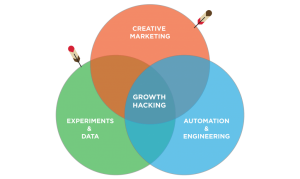Pune, Maharashtra Aug 19, 2020 (Issuewire.com) - If you work in a startup or run a business, chances are, you have come across the term “growth hacking.” It was coined by Sean Ellis in 2010 when he was trying to come up with a word for the kind of work he was doing to help startups: achieving accelerated growth with limited resources in a short period. So what constitutes growth hacking? How does it differ from traditional marketing? What are some tactics to employ? And how will your business benefit from it? We’re answering some of those questions in the list below.
Amol Ghemud, Co-Founder & Chief Growth Strategist at UpGrowth says "Growth hacking became crucial over the last decade due to superfast changes in technology, big data, shift from desktop to mobile and quick changing habits of users. Every business, startup wishes to find and implement the most effective ways to acquire users, retain most of them, and maximize revenues as early as possible."
Read More @ What is Growth Hacking – Tools, Strategies, Process and Case Studies
- Growth Hacking And Marketing Are Not The Same
Though there is some overlap to their functions, marketing and growth hacking are not the same. Both marketers and growth hackers work to acquire and retain customers, but growth hacking goes far beyond selling: theirs is a more holistic approach that embraces overall business growth using everything from creative marketing strategies to product development.
- Data & Innovation Are Key
Data is at the core of what growth hackers do. Everything needs to be measurable, scalable, trackable, and easy to calculate. Growth hackers look for small and powerful “hacks” – tips and tricks that are high on potential and low on cost. Thanks to technology, all these strategies can be evaluated and growth hackers can zero in on what is driving conversions, run A/B tests to track what isn’t working, and choose the most effective way forward. Since growth hackers must work within modest budgets, they often employ innovative approaches to achieve their targets.
- Product Market Fit – The Foundation Of Growth
Unlike marketers who receive a finished product and are tasked with selling it, growth hackers often get involved in the product development stage itself, testing and improving the product to fit the needs of the consumer. They focus on what the customer is looking for, addressing their pain points, and working to create the ideal product-market fit, instead of just trying to create a market for a finished product. This product-market fit is the foundation of growth.
- Content Marketing Is An Important Part Of Growth Hacking
Inbound marketing is an important part of growth – you are putting content out there that will help you get found by the right target audience. Content marketing is an effective way to spread the word about your product or service at a relatively low cost. This could be anything from a blog on your business website to authored articles on platforms like Medium to guest posting on other blogs.
- Businesses With Blogs Receive More Backlinks
So here’s the data: businesses with blogs receive more backlinks, giving your site a better chance of getting found on the web. A website with a separate blog section receives 97% more backlinks. A blog boosts website traffic, brand positioning, and is an efficient way to engage the customer. Be sure to make your blog SEO-friendly and most importantly, keep it consistent! Consistency is key. The more regular you are with your posts, the better it is for ranking and discovery.
- SEO & Organic Search Can’t Be Ignored
Great content isn’t enough: that content needs to be optimized for search engines. Did you know that over 40,000 searches are generated every second on Google? That’s a LOT of potential eyeballs on your business that could turn into paying customers. To be found by the right audience, your website needs to have the right keywords and phrases. Optimize your website for a strong online presence.
- But SEM Pays Rich Dividends Too
Having said that, keep in mind that SEM or search engine marketing can still generate a decent amount of revenue within a (relatively) short period. With SEM, you can make a more precise, targeted effort designed around a narrow group of people who will most likely have a greater interest in your product or service.
- Paid Advertisements Can Boost Brand Awareness By 80%
Yes, it’s true. Research from Google indicates that when done right, PPC campaigns are efficient and a great way of targeting the right audience, educating them about your product or service, and eventually converting them into paying customers.
- Optimization Is Important
When we say optimization is important, we mean that every aspect of your website. This includes everything from keywords to page speed and marketing automation tools. Do you have videos on your site? Optimize them to make sure they play quickly and load fast. You should also run A/B tests on your site to take account of what is working and what isn’t. For example, if you have an eCommerce website, play around with your product pages and how each product is laid out and presented. See how users respond and zero-in on the layout which is leading more people to click through and make a purchase.
- Location-Based Searches Are Gaining Traction
Now more than ever due to the COVID-19 pandemic, consumers are turning to local businesses to meet their needs. 72% of customers who run an online search will visit a shop within 8 km of where they are…there’s a reason that searches like “medical shop near me” are so popular! Make sure your business has a Google Business listing.
- Over 90% of B2B Companies Use LinkedIn For Marketing
LinkedIn and Facebook offer some of the best real estates when it comes to paid marketing. Especially if you’re selling B2B, LinkedIn is where you need to be. Use it to your advantage and run a paid campaign – the results will be there for you to see.
- Quick Follow Ups Give 9x Chances Of Conversions
Leads are not going to convert on their own – they often need a gentle nudge in the right direction. Following up on leads with 5 mins of making the connection gives you a 9x greater chance of converting them into customers. The sooner you make the connection and follow up on the lead, the easier it will be for them to remember your business. It’s important to stay on top of mind when it comes to potential customers. But remember to do it efficiently – too much aggression and they are likely to block you and not make a purchase.
- Don’t Ignore Referral Schemes
Referral schemes are still a great way to grow your customer base and retain loyalty. Offer a freebie to every existing customer who brings a new one your way. Anything from an upgrade to a discount to a free item works.
- Utilize Social Media To Amplify Your Message
Social media is everywhere and has become part and parcel of many people’s lives. Use it to promote your product, connect with potential customers, and build a brand. Social media is a triple threat: it gives you the benefit of being able to post images, video, and text and create a message that resonates. It’s free publicity for your brand! Apart from posting on the big 3 like Facebook, Twitter, and Instagram, you should also check out online communities and forums that relate to your business and start posting helpful information there. This will lead to your business getting discovered by people who are already aligned with what you have to offer.
- Email Marketing Is Not Dead
Email remains one of the most effective ways to communicate directly with your customer base. 91% of consumers check their email daily. 77% of B2B companies use newsletters to amplify their content. If you already have a dedicated list of subscribers? Share your latest blog post or piece of content with them, and ask them to share it on their social media handles and with their network. This may give you the opportunity to guest post on someone else’s page, plus it helps generate views and backlinks. So, remember to add an email sign up or opt-in somewhere on your site – those email addresses are gold, waiting to be tapped!
So these are a few ways to use growth hacking to give your business a boost – which one will you try first?
Take your business to the next level with Growth Hacking! Take a look at how UpGrowth helped various businesses to grow!
Media Contact
Growth Hacking Services contact@upgrowth.in http://upgrowth.in/









